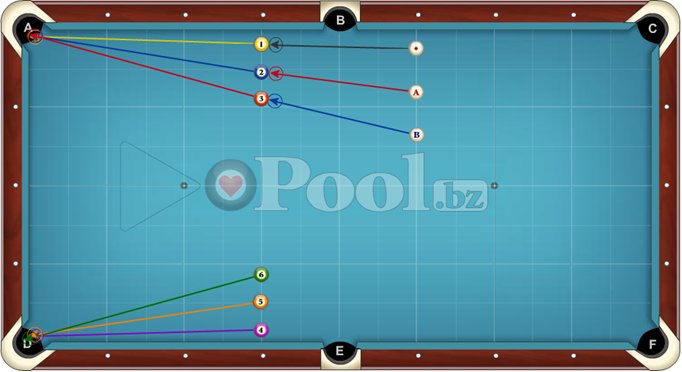This is a fantastic drill for practicing and tightening up your position routes. It teaches you to work in groups of three and how to stay focused on those last few balls on the table. It was first shown to me by Jerry Briesath, a master instructor, and is simple in concept yet very, very effective as a practice drill. So simple in fact that no pictures are needed... :)
Throw 3 balls out on the table in a random fashion. If you are a higher level intermediate or advanced player you can skip past 3 and start with 4 balls. In the event the balls stick together and form a cluster, just separate them a little, this isn't about working on tough run outs. Take ball in hand, and try to run the balls in order. Do it 20 times, and score 1 point for every time you run out successfully, if you miss you get no score and throw the balls out again.
Simple right? However, there's a twist - the "perfect" part in the name. While playing position, you must leave yourself a reasonable shot on the next ball and be more or less where you intended to be. No banks, no table length 90 degree cuts, no lucky shape (you were playing for the side but overran the position and went 2 extra rails and got shape for the corner), etc. Now this will vary based on your skill level - an advanced player can accept a slightly longer shot or a more severe cut angle than a beginner - essentially their effective position zone is a little larger. Just be honest and use your best judgement - you know where you were trying to get to, if you would be happy with that position and be more than 80% to make the shot in a real game then you're fine.
Score yourself out of 20 attempts, and when you can score 15 or 16 out of 20 then add another ball. Even intermediate players have a hard time with 3 balls if they aren't consistent shot makers or don't have a good handle on common position concepts and routes. Getting to 5 or 6 balls takes some skill and practice. When I do this drill, I use 6 balls and usually get 13 to 15 out of 20, still not consistently good enough to move to 7. Yet I can crush the 7 ball ghost, since the "perfect" part does not apply and I can come with a shot and continue my run. I grade myself harshly when doing the drill, really the only way to use it to tighten up your game. Jerry said that even pros would have a hard time getting past 7 balls with these rules in place - I've never seen one try this drill but it makes sense - watch a typical match and you'll see where certain mistakes would cost a pro that attempt, even though in the real game they successfully made a lower percentage shot or played a great safe to win the game.
In order for this to be a teaching exercise, when you miss the shot put the ball back where it was and try again. If you missed position, put the ball you made back and the cue ball back as best as you can and try the route again, tweaking speed/english as necessary. If you ended up in a bad spot and find it tough to get position, then put the previous ball back up on the table and figure out if maybe you should have had a better angle, been on a different side, or taken a different route to the spot where you messed up. If you are having a hard time figuring out what routes to take or what you are doing wrong, then consult with a better player in the room or an instructor to work on your position play decision making and routes.
This teaching component, as well as the pressure component of scoring yourself out of 20 attempts, make this drill a great exercise. It also very close mimics end game situations in 9 ball, so once you are able to reliably get through 4 or 5 ball patterns, when someone scratches and you get ball in hand on the 6 ball you will have a lot of confidence to finish out that rack and win the game.
Good luck!




